Influence of Thermal Aging Parameters on the Characteristics of Aluminum Semi-Solid Alloys
Abstract
1. Introduction
2. Materials and Methods
3. Results and Discussion
3.1. Electrical Conductivity and Micro-Hardness
3.2. Tensile Properties
3.3. Microstructure Characterization
3.3.1. SEM Analysis
3.3.2. TEM Analysis
4. Conclusions
- The hardness results obtained after the T6 continuous aging treatment (WA0) of A357SSM alloys are not improved by means of T6/T7 aging (A) cycles. However, the application of T6/T7 aging (WA1) cycle and of T7/T6 aging (B) cycles improved the hardness and Tensile strength values compared to T6 under aging (WA0) and T7 standard over aging (WB0) conditions, respectively.
- The application of multiple aging (B) cycles (T7/T6) indicates a continuous increase in the hardness and strength values with increasing the time of second thermal aging step till five, followed by a decrease in its mechanical values (over-aging). The application of Interrupted aging cycles (WC3) leads to increasing the strength values to be higher than those obtained by most of the applied thermal treatment cycles.
- The two steps thermal aging (WA1–8) cycles (T6/T7) indicated an improvement of ductility values by increasing the time of the second step of thermal aging.
- The electrical conductivity values increase continuously with increasing aging temperature by applying T7 aging directly after T6 condition (T6/T7). In addition, there is a reverse relationship between electrical conductivity and hardness values as relating to different aging cycles applied in this study.
- The water quenching of A357 SSM indicated higher hardness values compared to direct Air quenching-aging alloys. The air quenching results in the formation of hardening Mg2Si phases out of Aluminum matrix-solid solution (as shown in SEM microstructures) resulting in a negative effect on the mechanical properties of Alloys investigated.
- Regarding to the TEM observations, the application of interrupted aging (WC3) cycles and two step T7/T6 aging (WB5 and WB8) cycles leads to formation of different precipitate sizes that are mostly related to β’’ and β’ phases. The shorter/finer precipitates formed by applying T6 second aging step, alongside the coarse precipitates size formed by T7 first step aging that resulted in a significant increase in the hardness values compared to the T7 single step aging cycle (WB0).
Author Contributions
Funding
Acknowledgments
Conflicts of Interest
References
- Rosso, M. The Influence of Casting Process on Quality and Performances on Al Based Automotive Components. In Proceedings of the 13th International Scientific Conference on Achievements in Mechanical and Materials Engineering, Gliwice-Wista, Poland, 16–19 May 2005; pp. 547–550. [Google Scholar]
- Langlais, J.; Lemieux, A. The SEED technology for semi-solid processing of aluminum alloys: A metallurgical and process overview. Solid State Phenom. 2006, 116–117, 472–477. [Google Scholar] [CrossRef]
- Davis, J.R. ASM Specialty Handbook: Aluminum and Aluminum Alloys; ASM International: Materials Park, OH, USA, 1993. [Google Scholar]
- Askeland, D.R.; Phule, P.P. The Science and Engineering of Materials, 4th ed.; Thomson Brooks: Pacific Grove, CA, USA, 2003; pp. 366, 373, 374. [Google Scholar]
- Fridlyander, I.N.; Sister, V.G.; Grushko, O.E.; Berstenev, V.V.; Sheveleva, L.M.; Ivanova, L.A. Aluminum alloys: Promising materials in the automotive industry. Met. Sci. Heat Treat. 2002, 44, 365–370. [Google Scholar] [CrossRef]
- Wang, Q.G.; Davidson, C.J. Solidification and precipitation behaviour of Al-Si-Mg casting alloys. J. Mater. Sci. 2001, 36, 739–750. [Google Scholar] [CrossRef]
- Martin, J.W. Precipitation Hardening; Butterworth-Heinemann: Oxford, UK, 1998; p. 215. [Google Scholar]
- Zhang, D.L.; Zheng, L.H.; StJohn, D.H. Effect of a short solution treatment time on microstructure and mechanical properties of modified Al-7wt.% Si-0.3 wt.% Mg alloy. J. Light Met. 2002, 2, 27–36. [Google Scholar] [CrossRef]
- Li, B.; Wang, H.W.; Jie, J.C.; Wei, Z.J. Effects of yttrium and heat treatment on the microstructure and tensile properties of Al–7.5 Si–0.5 Mg alloy. Mater. Des. 2011, 32, 1617–1622. [Google Scholar] [CrossRef]
- Shivkumar, S.; Keller, C.; Apelian, D. Aging behavior in cast Al-Si-Mg alloys. AFS Trans. 1990, 98, 905–911. [Google Scholar]
- Abdulwahab, M.; Madugu, I.A.; Yaro, S.A. Effects of temper conditions and step-quenching-ageing on the hardness characteristics and yield strength of A356.0-type Al-Si-Mg alloy. Silicon 2012, 4, 137–143. [Google Scholar] [CrossRef]
- Li, R.X.; Li, R.D.; Zhao, Y.H.; He, L.Z.; Li, C.X.; Guan, H.R.; Hu, Z.Q. Age-hardening behavior of cast Al-Si base alloy. Mater. Lett. 2004, 58, 2096–2101. [Google Scholar] [CrossRef]
- Andersen, S.J.; Marioara, C.D.; Vissers, R.; Frøseth, A.; Zandbergen, H.W. The structural relation between precipitates in Al-Mg-Si alloys, the Al-matrix and diamond silicon, with emphasis on the trigonal phase U1-MgAl2Si2. Mater. Sci. Eng. A 2007, 444, 157–169. [Google Scholar] [CrossRef]
- Matsumoto, K.; Komatsu, S.-y.; Ikeda, M.; Verlinden, B.; Ratchev, P. Quantification of volume fraction of precipitates in an aged Al-1.0 mass% Mg2Si alloy. Mater. Trans. 2000, 41, 1275–1281. [Google Scholar] [CrossRef]
- Ding, L.P.; Jia, Z.H.; Nie, J.F.; Weng, Y.Y.; Cao, L.F.; Chen, H.W.; Wu, X.Z.; Liu, Q. The structural and compositional evolution of precipitates in Al-Mg-Si-Cu alloy. Acta Mater. 2018, 145, 437–450. [Google Scholar] [CrossRef]
- Salazar-Guapuriche, M.A.; Zhao, Y.Y.; Pitman, A.; Greene, A. Correlation of strength with hardness and electrical conductivity for aluminium alloy 7010. Mater. Sci. Forum. 2006, 519, 853–858. [Google Scholar] [CrossRef]
- Ravi, C.; Wolverton, C. First-principles study of crystal structure and stability of Al-Mg-Si-(Cu) precipitates. Acta Mater. 2004, 52, 4213–4227. [Google Scholar] [CrossRef]
- Zhang, J.Y.; Ma, M.Y.; Shen, F.H.; Yi, D.Q.; Wang, B. Influence of deformation and annealing on electrical conductivity, mechanical properties and texture of Al-Mg-Si alloy cables. Mater. Sci. Eng. A 2018, 710, 27–37. [Google Scholar] [CrossRef]
- Ferragut, R.; Somoza, A.; Torriani, I. Pre-precipitation study in the 7012 Al-Zn-Mg-Cu alloy by electrical resistivity. Mater. Sci. Eng. A 2002, 334, 1–5. [Google Scholar] [CrossRef]
- Mavlyutov, A.M.; Bondarenko, A.S.; Murashkin, M.Y.; Boltynjuk, E.V.; Valiev, R.Z.; Orlova, T.S. Effect of annealing on microhardness and electrical resistivity of nanostructured SPD aluminium. J. Alloys Compd. 2017, 698, 539–546. [Google Scholar] [CrossRef]
- Abdulwahab, M.; Madugu, I.A.; Yaro, S.A.; Hassan, S.B. Effects of multiple-step thermal ageing treatment on the hardness characteristics of A356. 0-type Al–Si–Mg alloy. Mater. Des. 2011, 32, 1159–1166. [Google Scholar] [CrossRef]
- Tiryakioğlu, M.; Campbell, J.; Staley, J.T. Hardness-strength relationships in cast Al-Si-Mg alloys. Mater. Sci. Forum. 2000, 331–337, 295–300. [Google Scholar] [CrossRef]
- Ragab, Kh.A.; Bouaicha, A.; Bouazara, M. Optimization of Casting Design Parameters on Fabrication of Reliable Semi-Solid Aluminum Suspension Control Arm. J. Mater. Eng. Perform. 2017, 26, 4450–4461. [Google Scholar] [CrossRef]
- Ragab, K.A.; Bouazara, M.; Bouaicha, A.; Allaoui, O. Microstructural and mechanical features of aluminium semi-solid alloys made by rheocasting technique. Mater. Sci. Technol. 2017, 33, 646–655. [Google Scholar] [CrossRef]
- Abubakre, O.K.; Mamaki, U.P.; Muriana, R.A. Investigation of the quenching properties of selected media on 6061 aluminum alloy. J. Min. Mater. Charact. Eng. 2009, 8, 303–315. [Google Scholar] [CrossRef]
- Gupta, A.K.; Lloyd, D.J. Precipitation hardening in Al-Mg-Si alloys with and without excess Si. Mater. Sci. Eng. A 2001, 316, 11–17. [Google Scholar] [CrossRef]
- Murayama, M.; Hono, K. Pre-precipitate clusters and precipitation processes in Al–Mg–Si alloys. Acta Mater. 1999, 47, 1537–1548. [Google Scholar] [CrossRef]
- Ding, L.P.; Jia, Z.H.; Zhang, Z.Q.; Sanders, R.E.; Liu, Q.; Yang, G. The natural aging and precipitation hardening behavior of Al-Mg-Si-Cu alloys with different Mg/Si ratios and Cu additions. Mater. Sci. Eng. A 2015, 627, 119–126. [Google Scholar] [CrossRef]
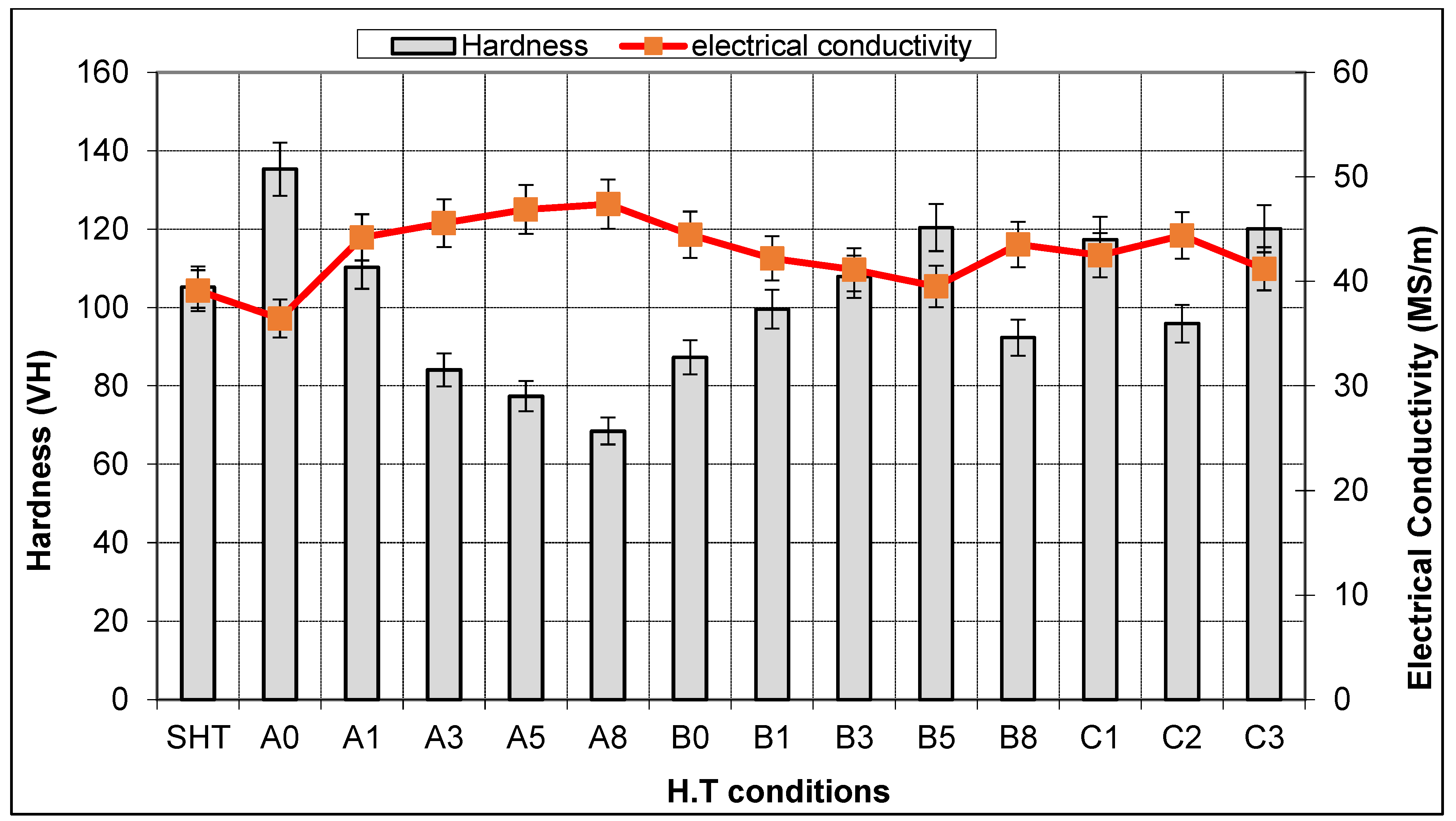
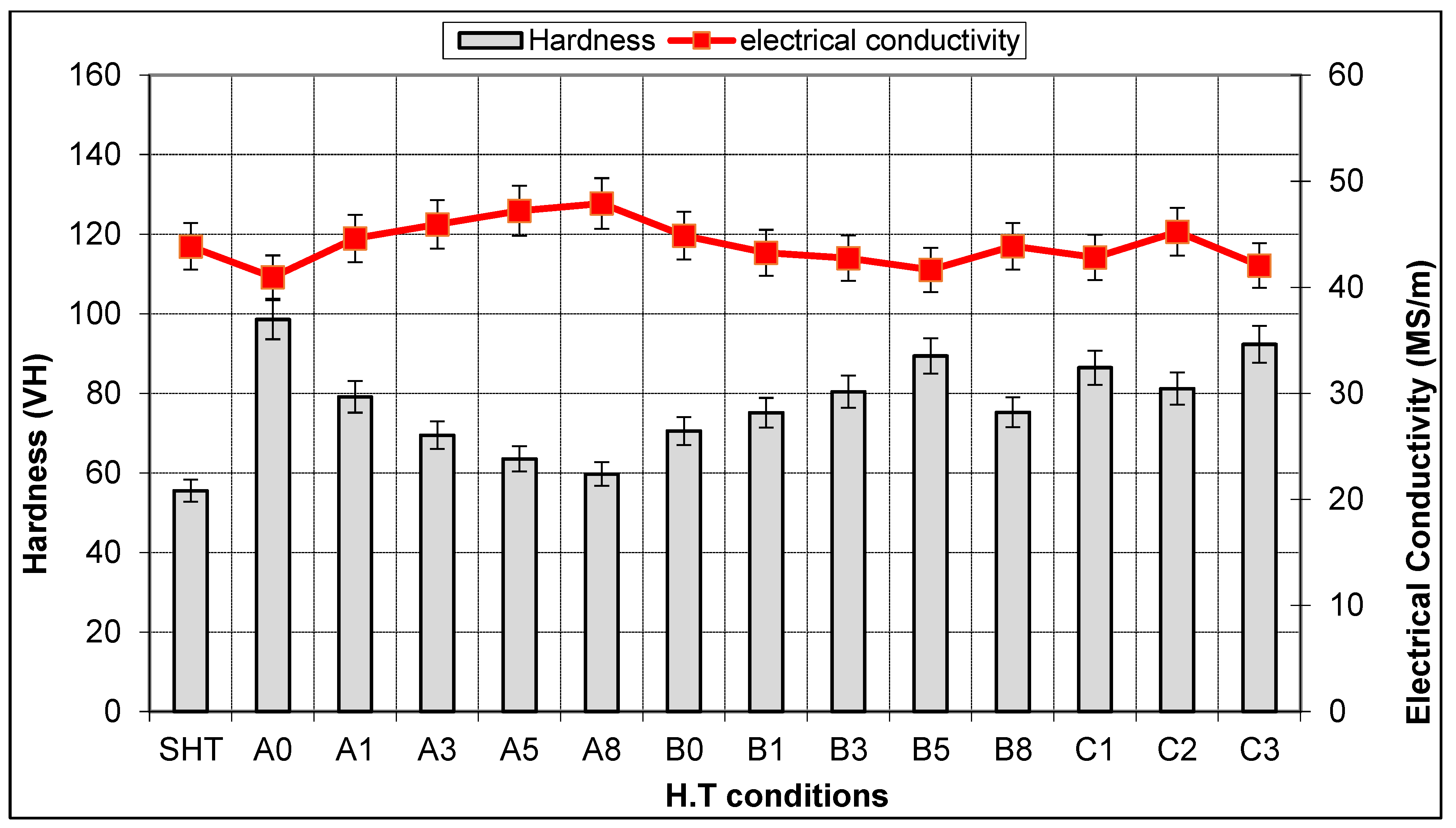
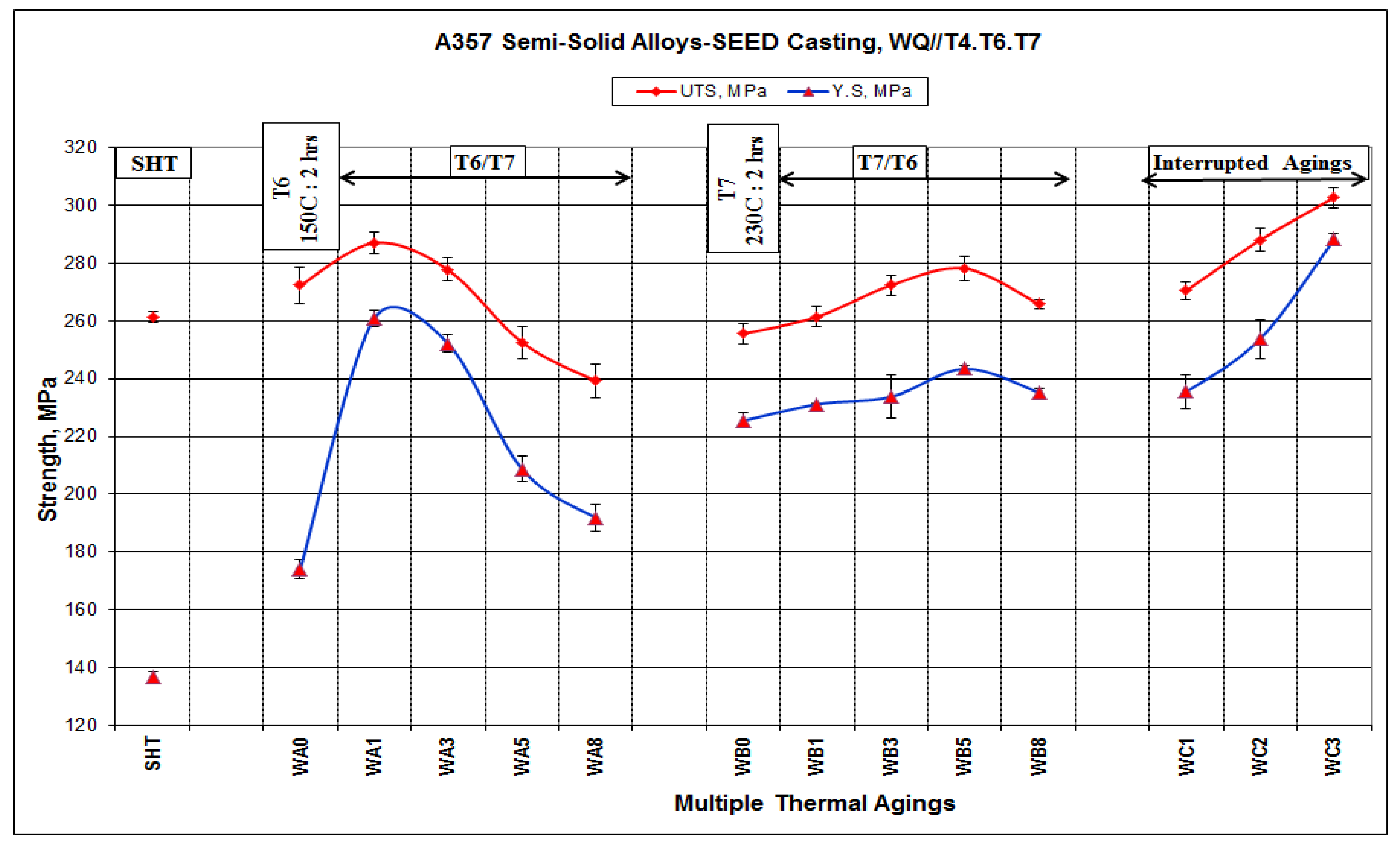
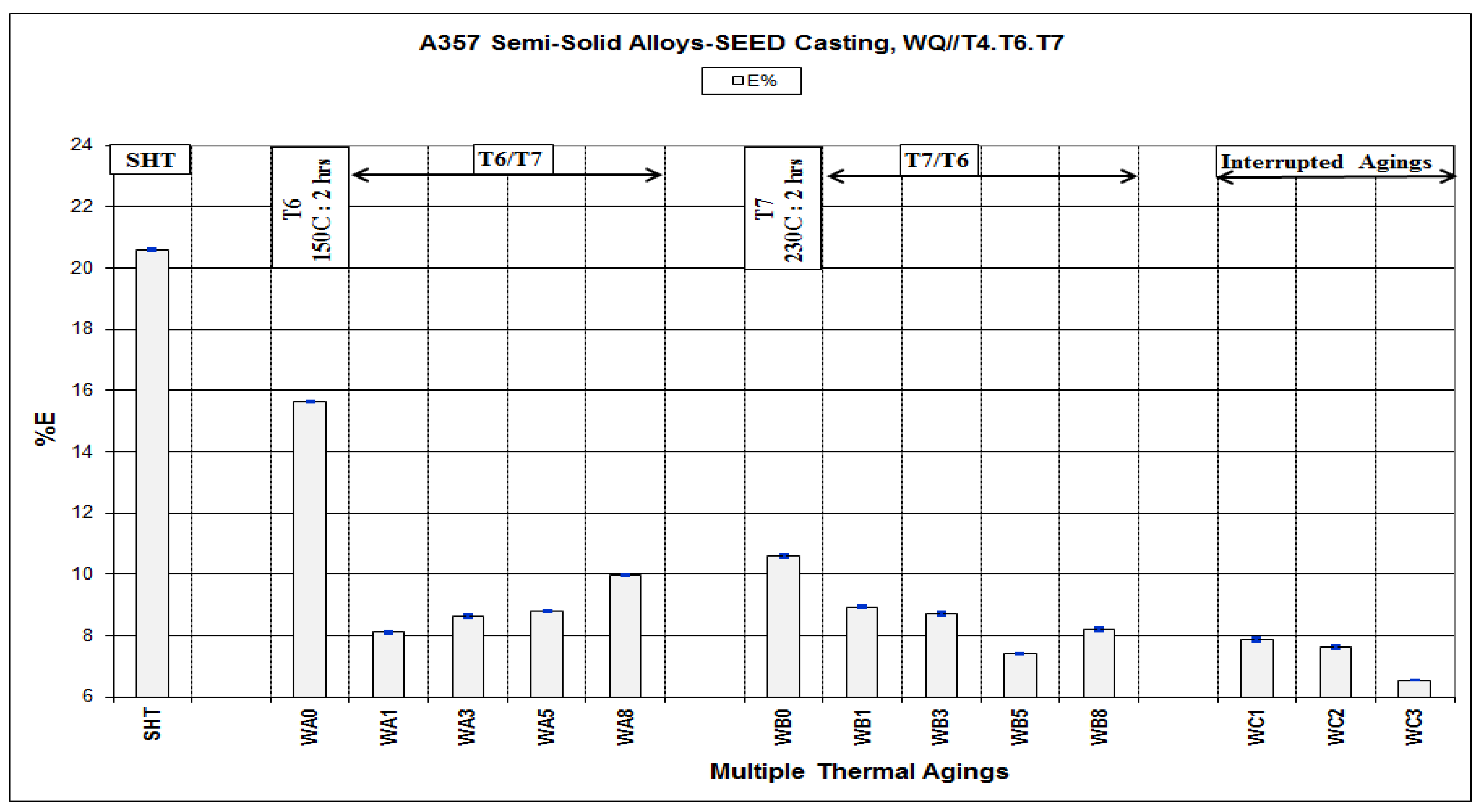
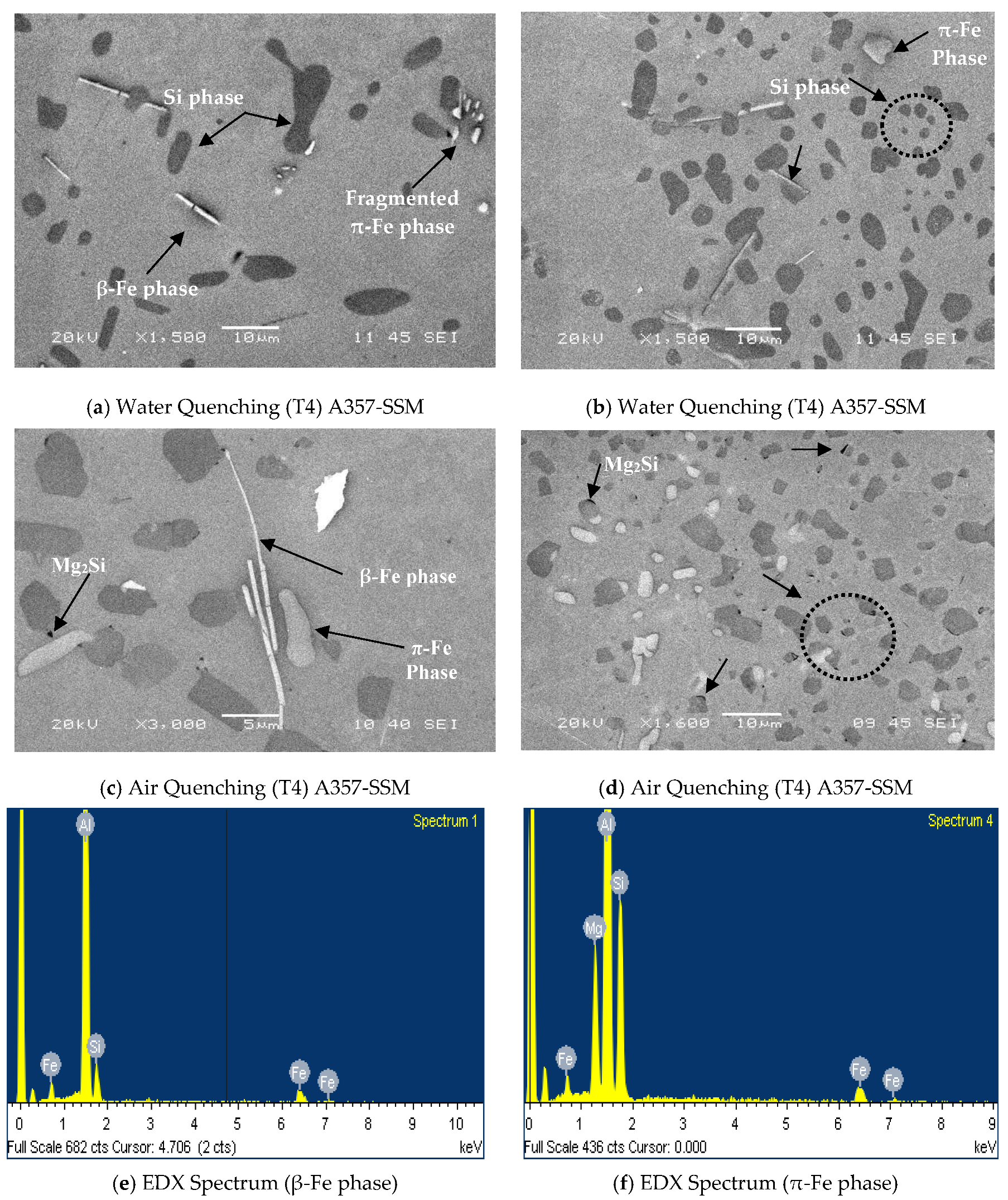
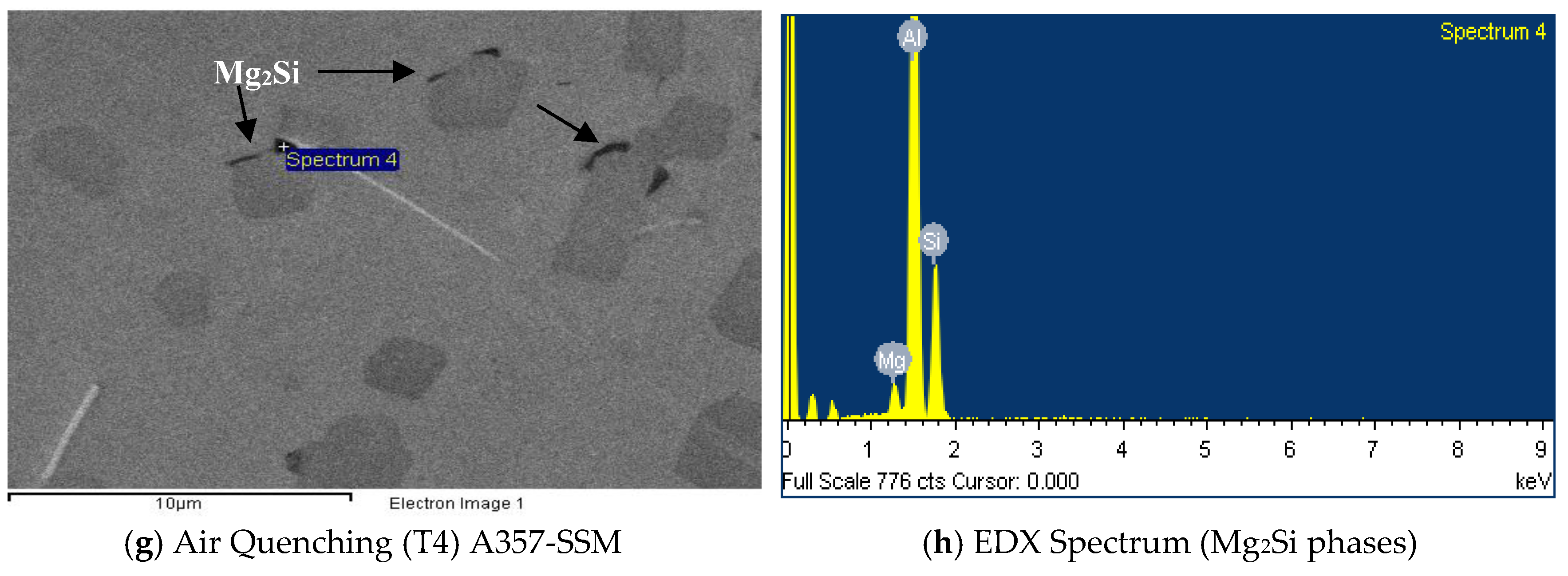
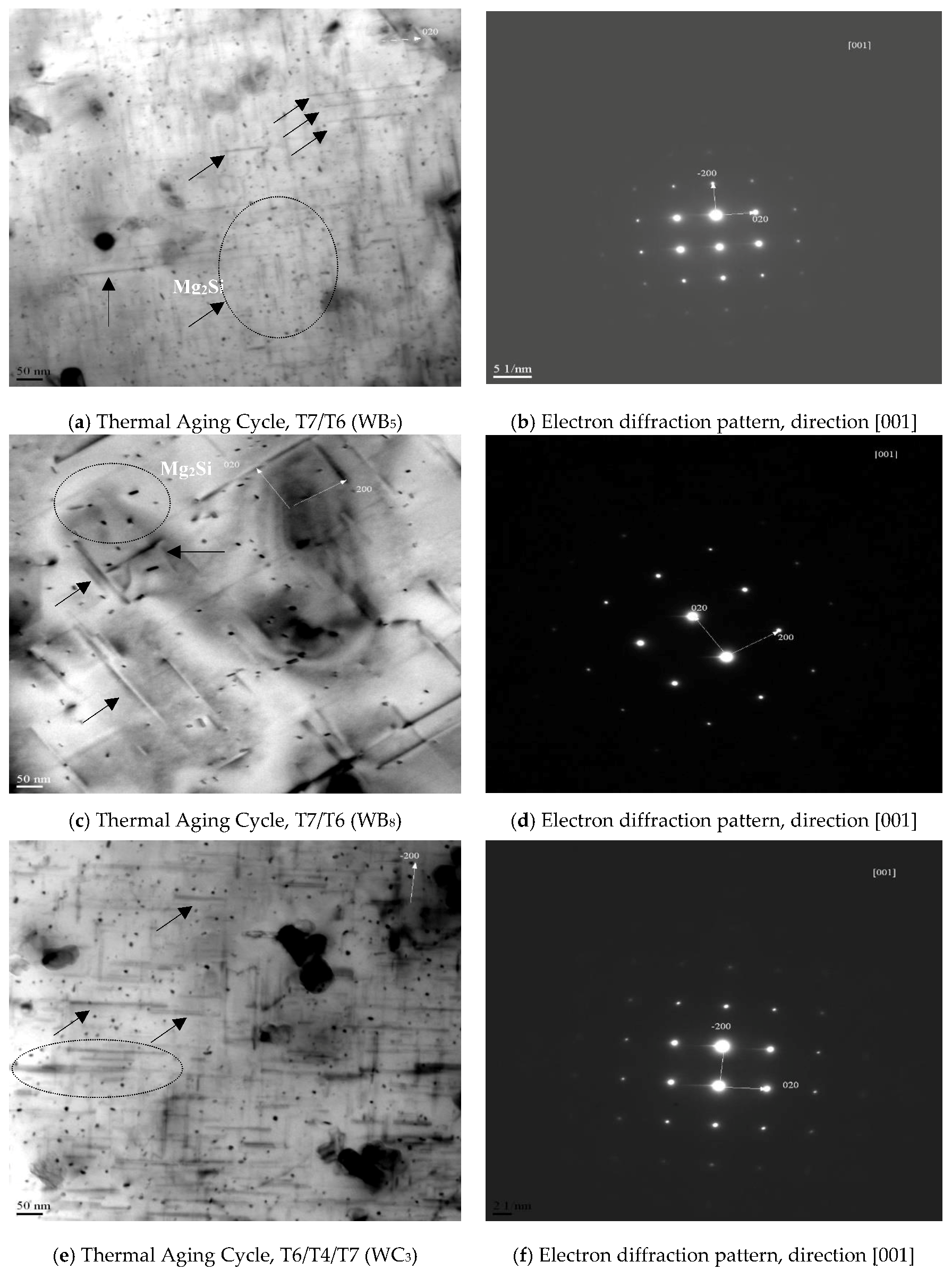
| Heat Treatment Regimes | |||||
|---|---|---|---|---|---|
| Aging Cycles ID | SHT * | Quench | Age 1 | Age 2 | Age 3 |
| SHT | 470 °C, 1 h + 540 °C, 5 h | 60 °C water | - | - | - |
| A: Multiple Aging cycles (T6/T7) | |||||
| WA0 (T6/T7) | 470 °C, 1 h + 540 °C, 5 h | 60 °C water | 150 °C–2 h | 230 °C–0 h | - |
| WA1 (T6/T7) | 150 °C–2 h | 230 °C–1 h | - | ||
| WA3 (T6/T7) | 150 °C–2 h | 230 °C–3 h | - | ||
| WA5 (T6/T7) | 150 °C–2 h | 230 °C–5 h | - | ||
| WA8 (T6/T7) | 150 °C–2 h | 230 °C–8 h | - | ||
| B: Multiple Aging cycles (T7/T6) | |||||
| WB0 (T7/T6) | 470 °C, 1 h + 540 °C, 5 h | 60 °C water | 230 °C–2 h | 150 °C–0 h | - |
| WB1 (T7/T6) | 230 °C–2 h | 150 °C–1 h | - | ||
| WB3 (T7/T6) | 230 °C–2 h | 150 °C–3 h | - | ||
| WB5 (T7/T6) | 230 °C–2 h | 150 °C–5 h | - | ||
| WB8 (T7/T6) | 230 °C–2 h | 150 °C–8 h | - | ||
| C: Interrupted Aging cycles (T6/T4/T7) | |||||
| WC1 (T6/T4/T7) | 470 °C, 1 h + 540 °C, 5 h | 60 °C water | 150 °C–1 h | 190 °C–1 h + 25 °C–24 h | 230 °C–2 h |
| WC2 (T6/T7/T7) | 150 °C–1 h | 190 °C–1 h | 230 °C–2 h | ||
| WC3 (T6/T4/T7) | 150 °C–3 h + 25 °C–24 h | 190 °C–2 h | 230 °C–1 h | ||
| Thermal Aging Cycles | Average Length, nm |
|---|---|
| WB5 (T7/T6) | 10.5 ± 1.4 nm 46.27 ± 0.6 nm 82.42 ± 1.7 nm 199.12 ± 1.2 nm |
| WB8 (T7/T6) | 28.1 ± 2.3 nm 56.7 ± 1.1 nm 98.47 ± 1.8 nm 245.21 ± 2.1 nm |
| WC3 (T6/T4/T7) | 10.32 ± 1.4 nm 32 ± 1.1 nm 80.5 ± 2.1 nm 206.47 ± 1.9 nm |
© 2018 by the authors. Licensee MDPI, Basel, Switzerland. This article is an open access article distributed under the terms and conditions of the Creative Commons Attribution (CC BY) license (http://creativecommons.org/licenses/by/4.0/).
Share and Cite
Ragab, K.A.; Bouazara, M.; Chen, X.G. Influence of Thermal Aging Parameters on the Characteristics of Aluminum Semi-Solid Alloys. Metals 2018, 8, 746. https://doi.org/10.3390/met8100746
Ragab KA, Bouazara M, Chen XG. Influence of Thermal Aging Parameters on the Characteristics of Aluminum Semi-Solid Alloys. Metals. 2018; 8(10):746. https://doi.org/10.3390/met8100746
Chicago/Turabian StyleRagab, Khaled Ahmed, Mohamed Bouazara, and Xiao Grant Chen. 2018. "Influence of Thermal Aging Parameters on the Characteristics of Aluminum Semi-Solid Alloys" Metals 8, no. 10: 746. https://doi.org/10.3390/met8100746
APA StyleRagab, K. A., Bouazara, M., & Chen, X. G. (2018). Influence of Thermal Aging Parameters on the Characteristics of Aluminum Semi-Solid Alloys. Metals, 8(10), 746. https://doi.org/10.3390/met8100746





